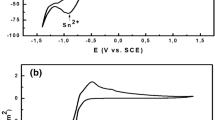Abstract
The structure and phase composition of silver-antimony alloy deposits plated from ferrocyanide-thiocyanate electrolytes is investigated. It is shown that the co-deposition of antimony leads to an abrupt decrease of twinning and the formation of perfect orientation of the crystallites in the alloy along the axis 〈1 1 1〉. The co-deposition of antimony exerts a depolarization effect upon the plating process of the alloy. At higher antimony concentrations in the electrolyte and higher deposition current both ξ-phase and ε-phase of the silver-antimony alloy may be formed as well as the pure antimony phase. The concentration regions of antimony in the alloy, within which the different phases are formed and exist, are in agreement with the requirements of the phase diagram. The separate antimony phase is formed at lower antimony concentrations in the alloy than indicated by the phase diagram. The co-deposition of antimony leads to an increase of the crystal lattice parameter of silver and a substantial augmentation of the hardness of the deposited layers.
Similar content being viewed by others
References
M. Hansen and K. Anderko, ‘Srukturi dvojnih splavov’, Metallurgizdat, Moscow, Vol. 1 (1962) p. 63 (in Russian).
H. Remy, ‘Lehrbuch der anorganischen Chemie’, Akad. Verlagsgesellschaft Geest & Portig K. G., Leipzig, Bd. I, (1960) p. 780.
A. Brenner, ‘Electrodeposition of Alloys’, Vol. 1, Academic Press, New York and London (1963) p. 8.
E. Raub, G. Dehoust and E. Ramcke,Metall. 22 (1968) 573.
L. Domnikov,Metal Finish. February (1966) 66.
US Patent 3 219 558 (1965).
German Patent 1 181 025 (1967).
German Patent 1 235 103 (1970).
German Patent 1 240 715 (1970).
German Patent 1 246 349 (1972)
USSR Patent 287 482 (1971).
Bulgarian Patent 21 747 (1975).
USSR Patent 2 651 041 (1980).
Bulgarian Patent 54 726 (1981).
E. Grünwald and C. Varhelyi,Galvanotechnik 70 (1979) 437.
S. H. Finkelstein, L. N. Vizgalova, G. A. Vartanova and J. I. Surov,Zashch. Met. 16 (1980) 639.
USSR Patent 2 659 324 (1980).
Bulgarian Patent 54 956 (1982).
P. M. Vjacheslavov, S. J. Griliches, G. K. Burkat and E. G. Kruglova, ‘Galvanotechnika blagorodnih i redkih metallov’, Mashinostroenie, Leningrad (1970) p. 48.
German Patent 2 650 030 (1977).
US Patent 4 246 077 (1981).
I. Kristev and M. Nikolova,J. Appl. Electrochem. 16 (1986) 703.
V. E. Dauiotis, G. A. Baltrunas and V. A. Kaikaris,Elektrokhimiya 19 (1983) 264 (in Russian).
M. R. Collonguess in Nouveau Traite de Chimie Minerale sous la Direction de Paul Pascal, Deuxieme Fasciculu, Masson et CIE, Paris, T. XX, (1963) p. 1014.
N. P. Fedotjev and P. M. Vjacheslovov,Plating July (1970) 700.
Author information
Authors and Affiliations
Rights and permissions
About this article
Cite this article
Kristev, I., Nikolova, M. Phase composition and structure of silver-antimony alloy deposits plated from ferrocyanide-thiocyanate electrolytes. J Appl Electrochem 16, 867–874 (1986). https://doi.org/10.1007/BF01006531
Received:
Revised:
Issue Date:
DOI: https://doi.org/10.1007/BF01006531




